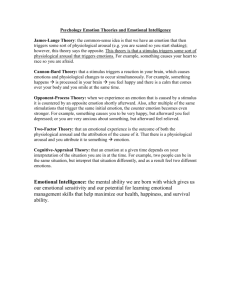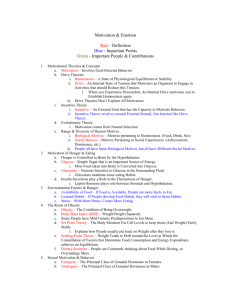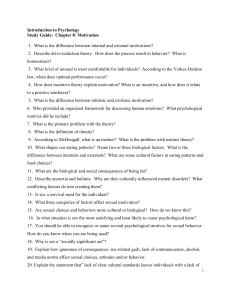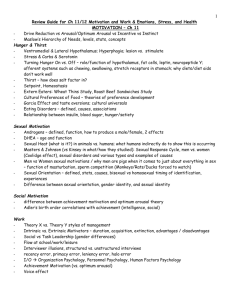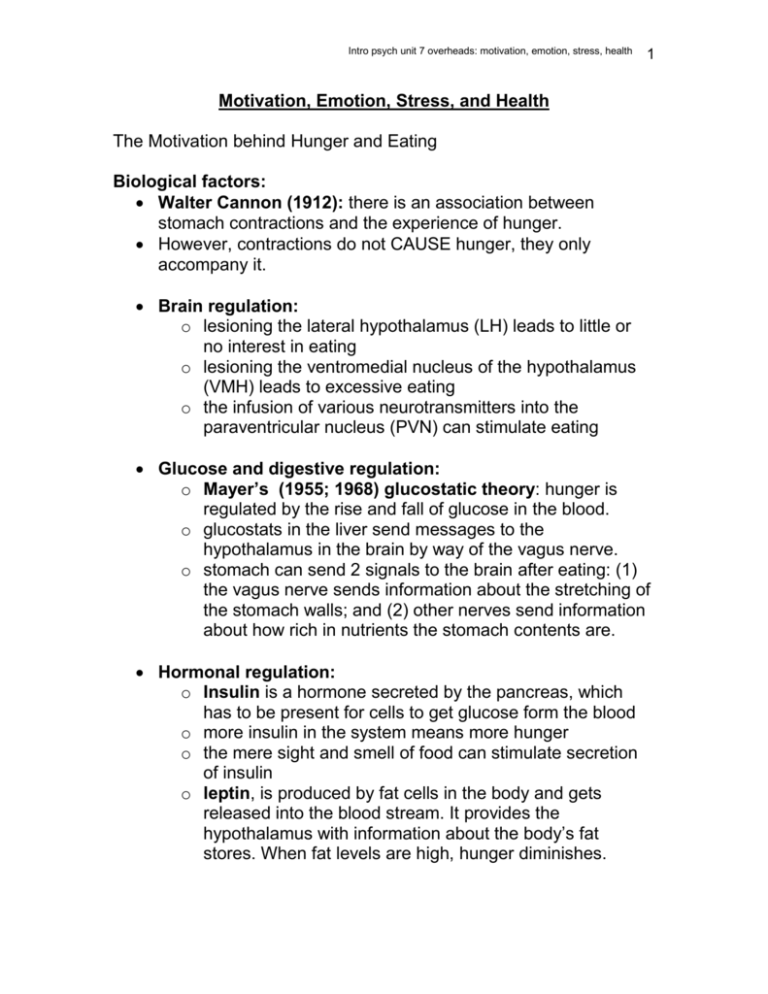
Intro psych unit 7 overheads: motivation, emotion, stress, health
1
Motivation, Emotion, Stress, and Health
The Motivation behind Hunger and Eating
Biological factors:
Walter Cannon (1912): there is an association between
stomach contractions and the experience of hunger.
However, contractions do not CAUSE hunger, they only
accompany it.
Brain regulation:
o lesioning the lateral hypothalamus (LH) leads to little or
no interest in eating
o lesioning the ventromedial nucleus of the hypothalamus
(VMH) leads to excessive eating
o the infusion of various neurotransmitters into the
paraventricular nucleus (PVN) can stimulate eating
Glucose and digestive regulation:
o Mayer’s (1955; 1968) glucostatic theory: hunger is
regulated by the rise and fall of glucose in the blood.
o glucostats in the liver send messages to the
hypothalamus in the brain by way of the vagus nerve.
o stomach can send 2 signals to the brain after eating: (1)
the vagus nerve sends information about the stretching of
the stomach walls; and (2) other nerves send information
about how rich in nutrients the stomach contents are.
Hormonal regulation:
o Insulin is a hormone secreted by the pancreas, which
has to be present for cells to get glucose form the blood
o more insulin in the system means more hunger
o the mere sight and smell of food can stimulate secretion
of insulin
o leptin, is produced by fat cells in the body and gets
released into the blood stream. It provides the
hypothalamus with information about the body’s fat
stores. When fat levels are high, hunger diminishes.
Intro psych unit 7 overheads: motivation, emotion, stress, health
2
Environmental factors:
learned preferences and habits
o people from different cultures display different patterns of
food consumption.
o preference for high-fat foods is partly genetic in origin
o condition people to prefer food associated with positive
consequences
o acquire taste aversions through conditioning when foods
are followed by nausea
o observational learning: food preferences are largely a
matter of exposure.
food related cues
o how appealing food looks, how available it is, how
convenient it is to eat, all influence whether and how
much you will eat
stress, arousal, and eating
o stress leads to increased eating for many people
o more common in women
o more likely in chronic dieters
o stress leads to physiological arousal, and arousal is linked
to overeating
Is there a genetic predisposition to obesity?
o Stunkard, Harris, Pederson, & McClearn (1990):
identical twins reared apart were far more similar in their
BMI than fraternal twins reared together
o Allison et al (1994): genetic factors account for 61% of
the variation in weight among men and 73% among
women
-----------------------------------------------------------------------------------------Sexual Attraction
evolutionary analysis: Robert Trivers (1972) parental investment
theory.
mating patterns depend on what each sex has to invest. The
sex that makes the smaller investment will compete for mating
opportunities with the sex that makes the larger investment,
which will be more discriminating in selecting its partners.
Intro psych unit 7 overheads: motivation, emotion, stress, health
3
Human males reproductive potential is maximized by mating
with as many females as possible
Females have no incentive to mate with many males. They can
optimize their reproductive potential by being selective in
mating.
males generally show a greater interest in sex than females do.
Men also have sex with more partners than women do, on
average.
Buss & Schmidt (1993): found that men were much more
likely than women to have sex with someone they had known
for only a brief period.
men are also much more likely to pursue casual sex with a
prostitute
men should place more emphasis on partner characteristics like
youthfulness (correlated with health and fertility), while women
are looking for males who show the ability to provide for and
protect them and potential offspring (so, traits like intelligence,
ambition, income, social status).
Sexual orientation: a person’s preference for emotional and sexual
relationships with individuals of the same sex , the other sex, or either
sex.
Alfred Kinsey (1948; 1953): Sexual orientation is more
accurately understood as a continuum rather than a set of
categories.
around 5 to 8% of the population is homosexual
Environmental theories of sexual orientation
psychoanalytic theorists: a male is likely to become gay
when raised by a weak father and an overprotective mother
behavioural theorists: homosexuality is a learned preference
acquired when same-sex stimuli have been paired with sexual
arousal, perhaps through chance seductions by adult
homosexuals
research has failed to support either of these views
Intro psych unit 7 overheads: motivation, emotion, stress, health
4
research HAS found:
o 75 -90% of highly feminine young boys eventually turn out
to be gay
o most gay men and women report that they can trace their
homosexual leanings back to their early childhood
o because of negative parental and societal attitudes, they
struggled to deny their sexuality.
o suggests a more biological cause than environmental.
Biological theories of sexual orientation
Bailey & Pillard (1991): studied gay men who had either a twin
brother or an adopted brother.
o 52% of the subjects’ identical twins were also gay
o 22% of the subjects’ fraternal twins were also gay
o 11% of the subjects’ adoptive brothers were also gay
o suggests a genetic predisposition to homosexuality
LeVay (1991; 1993): reported anatomical differences between
gay and straight men in a region of the brain thought to
influence sexual behaviour.
o cluster of neurons in the anterior hypothalamus known to
be larger in men than women
o found that this structure was only half as large in gay men
as it was in heterosexual men
o However, most of his gay subjects had died of AIDs potential confound!
current view is that prenatal hormones may alter the brain
structure and subsequent neurological development.
o During critical periods of prenatal development, hormonal
secretions may shape sexual development and influence
orientation
Intro psych unit 7 overheads: motivation, emotion, stress, health
5
Interactionist view of sexual orientation
identical twins of gay individuals are gay 50% of the time;
genetic predisposition is not overpowering.
Daryl Bem’s (1996, 1998) interactionist theory: genes and
prenatal hormones shape a child’s temperament, which initiates
a chain of events that ultimately shapes sexual orientation.
o Kids who do not conform to gender norms are often
teased by their same-sex peers
o This leads to emotional arousal regarding same sex peers
that somehow gets transformed into sexual attraction to
them
criticism: how does this final step work?
implications: if research were to show that being gay is a matter of
biology, then the arguments against equal rights for gays would
disintegrate.
The Human Sexual Response
Masters & Johnson found the sexual response cycle has 4
stages
1) Excitement phase.
2) Plateau phase.
3) Orgasm phase.
4) Resolution phase.
-------------------------------------------------------------------------------------------Affiliation: the search for belongingness
Baumeister & Leary (1995): bonding offers lots of survival
benefits
o the quality of people’s relationships is a major
determinant of their happiness
Thematic Apperception Test (TAT), a projective test.
o people who score high on the need for affiliation devote
more time to interpersonal activities and worry more
about acceptance. They get more anxious when being
evaluated socially, and try not to be argumentative in
groups for fear of rejection.
Intro psych unit 7 overheads: motivation, emotion, stress, health
6
The achievement motive: the need to master difficult challenges,
to outperform others, and to meet high standards of excellence.
David McClelland (1985) believes that this motivation is
pivotally important
fairly stable aspect of personality, measured with the TAT
people who score high tend to work harder and more
persistently on tasks than others
they are more future oriented than others, more likely to delay
gratification to pursue long term goals
go into competitive entrepreneurial careers
usually more successful
they do not always tackle the biggest challenges available; they
tend to select tasks of intermediate difficulty.
Situational Determinants of Achievement Behaviour
Atkinson (1992): the tendency to pursue achievement
depends on (a) the strength of one’s motivation, (b) one’s
estimate of the probability of succeeding, and (c) the incentive
value of success
as tasks get easier, success gets less rewarding. As they get
harder, success gets “sweeter”, but its likelihood declines. So
moderately challenging tasks seem to offer the best overall
value in terms of maximizing one’s sense of accomplishment.
------------------------------------------------------------------------------------------Emotional Experience
Emotion: involves (1) a subjective conscious experience,
accompanied by (2) bodily arousal and by (3) characteristic overt
expressions (i.e., cognitions, physiology, and behaviour.)
The cognitive component:
emotion is a subjective experience
people report that they are internal feelings that have a life of
their own
emotions tend to involve automatic reactions that are hard to
regulate
cognitive appraisals of events are key determinants of the
emotions people experience.
people also evaluate their emotions as pleasant or unpleasant
Intro psych unit 7 overheads: motivation, emotion, stress, health
7
The physiological component:
autonomic arousal: autonomic nervous system (regulating the
glands, smooth muscles, blood vessels)
o fight-or-flight response, modulated by the release of
adrenal hormones
o galvanic skin response (GSR): a good index of
autonomic arousal in lab studies
neural circuits: the hypothalamus, amygdala and adjacent
structures in he limbic system
o if an animal’s amygdala is destroyed, it is unable to learn
conditioned fear responses
o in humans the amygdala is activated when people are
shown emotion-arousing stimuli pictures of different facial
expressions of fear
o LeDoux (1996): the “vigilance system”
sensory inputs thalamus
↓
↓
amygdala cortex
↓
↓
faster!
more thorough!
The behavioural component:
Paul Ekman & Wallace Friesen (1984): people can identify 6
fundamental emotions: happiness, sadness, fear, anger,
surprise, and disgust.
The facial feedback hypothesis: facial muscles send signals
to the brain that help the brain recognize the emotion that one
is experiencing.
The expressions that go with emotions may be innate.
The cultural component:
similarities:
o agreement across cultures on identifying happiness,
sadness, anger, fear, surprise, and disgust
o people evaluate situations along the same dimensions
o same physiological arousal
Intro psych unit 7 overheads: motivation, emotion, stress, health
8
differences:
o James Russell (1991): many English words for emotions
that have no equivalent in other languages
o display rules differ from culture to culture: norms for
regulating the appropriate expression of emotions
Theories of Emotion
The James-Lange theory (1885): Different patterns of autonomic
activation lead to the experience of different emotions. The
physiology comes first; then we identify it.
Criticism of the James-Lange theory:
(a) physiological arousal can occur without emotion
(b) visceral changes are too slow to precede the conscious
experience of emotion
(c) people experience different emotions with the same patterns
of arousal.
The Cannon-Bard theory: emotion occurs when the thalamus sends
signals simultaneously to the cortex and the ANS.
The 2-Factor Theory (Stanley Schacter): Emotion depends on 2
things: (1) autonomic arousal, and (2) our cognitive interpretation of
that arousal.
Dutton & Aron (1974): dangerous footbridge versus safe
footbridge study.
People infer their emotion from their arousal and label it in
accordance with their cognitive explanation for it.
The Evolutionary Perspective on Emotion
Darwin: emotions developed because of their adaptive value
innate reactions to certain stimuli, immediately recognizable
without much thought
Emotion evolved before thought
originate in subcortical regions of the brain
a small number of innate emotions: fear, anger, joy, disgust,
interest, and surprise.
other emotions are a mix of these and/or variations in intensity
Intro psych unit 7 overheads: motivation, emotion, stress, health
9
Stress: circumstances that threaten or are perceived to
threaten one’s well-being and that thereby tax one’s coping
abilities.
Stress is cumulative and subjective
Some people are more prone than others to feel threatened by
life’s difficulties.
4 major types of stress
1) Frustration
2) Conflict: there are three types (Lewin (1935), Miller (1959))
i) approach-approach conflict
ii) avoidance-avoidance conflict
iii) approach-avoidance conflict
3) Changes: noticeable alterations in one’s circumstances that
require readjustment.
* Holmes & Rahe’s (1967) Social Readjustment Rating
Scale (SRRS)
* higher scores on the SRRS: more physical and
psychological problems
* it’s really measuring “negative change”
4) Pressure: expectations to behave in certain way.
* Weiten’s (1988) scale to measure pressure as a form of
life stress
* relationship between pressure and psychological
problems
* many people “choke” under pressure
Emotional responses to stress:
o Daily fluctuations in stress correlate with daily fluctuations
in mood
o strong links between specific cognitive reactions to stress,
and specific emotions.
o emotional arousal: the inverted-U relationship with
performance
o More complex tasks have a lower optimal level of arousal;
less complex tasks have a higher optimal level.
Intro psych unit 7 overheads: motivation, emotion, stress, health
10
Physiological responses to stress:
o Fight-or-flight (Walter Cannon, 1932)
sympathetic division of the ANS
less adaptive in the modern world of humans
being in a fight-or-flight arousal state for long
periods can have negative health consequences.
o the General Adaptation Syndrome (GAS) (Hans
Selye). The body’s stress response consists of 3 stages
alarm
resistance
exhaustion
o there are 2 major pathways along which the brain sends
signals to the endocrine system in response to stress.
via the sympathetic division of the ANS, making the
adrenal glands secrete catecholamines into the
blood. These produce the fight-or-flight response.
hypothalamus sends signals to the pituitary gland,
which then secretes ACTH to stimulate the adrenal
glands to secrete corticosteroids, which stimulate
the release of fat stores and proteins, and inhibit
tissue inflammation.
Behavioural responses to stress
o coping: active efforts to master, reduce, or tolerate the
demands created by stress
Striking out at others.
Aggression: behaviour intended to hurt
someone.
The frustration-aggression hypothesis:
aggression is always caused by frustration.
Freud: acting aggressively could get pent-up
emotion out of the system (catharsis).
But aggression does not reliably lead to
catharsis
Intro psych unit 7 overheads: motivation, emotion, stress, health
11
Indulging oneself: overeating, smoking, alcohol
and drugs
Defensive coping: reactions that protect a person
from unpleasant emotions such as anxiety and guilt.
They rely on avoiding problems instead of facing
them.
Constructive coping
o not related to intelligence
o confronting problems directly
o realistic appraisals of stress and coping resources
o learning to recognize and control disruptive emotional
reactions
o making efforts to take care of your body
Effects of stress on psychological functioning:
o Impaired task performance
o Burnout: physical, mental, and emotional exhaustion
attributable to long-term involvement in emotionally
demanding situations.
o PTSD: enduring psychological disturbance attributed to
the experience of a major traumatic event
reexperiencing a traumatic event in the form of
flashbacks and nightmares, emotional numbing,
alienation, social problems, elevated arousal,
anxiety, and guilt
vulnerability to PTSD is related to lack of social
support and previous emotional problems.
Thomason (1992): association between life stress and the
course of rheumatoid arthritis
Williams and Deffenbacher (1983): life stress is correlated
with the number of yeast infections women report
Intro psych unit 7 overheads: motivation, emotion, stress, health
12
stress alters the immune response: the body’s defensive
reaction to invasion by bacteria, viruses, or other foreign
substances.
o Immune responses depend on lymphocytes
o Kiecolt-Glaser (1995): medical students’ immune activity
is lower right before exams than a month before exams
stress and the common cold:
Cohen, Tyrell & Smith (1993): high stress subjects
were more likely than low-stress subjects to develop
a viral infection and get cold symptoms.
Variables that moderate the effects of stress:
social support
o Jemmot & Magliore (1988): students who reported
stronger social support had higher levels of an antibody
that fights off respiratory infections.
optimism and conscientiousness:
o Scheier & Carver (1985): correlation between optimism
and physical health in college students.
o Optimists cope with stress in more adaptive ways than
pessimists
o Peterson & Seligman: a pessimistic explanatory style is
associated with poorer health.
o Friedman (1993):relationship between conscientiousness
and physical health.
autonomic reactivity: Certain patterns of cardiovascular
reactivity probably make some people more vulnerable than
others to stress-related heart disease.




